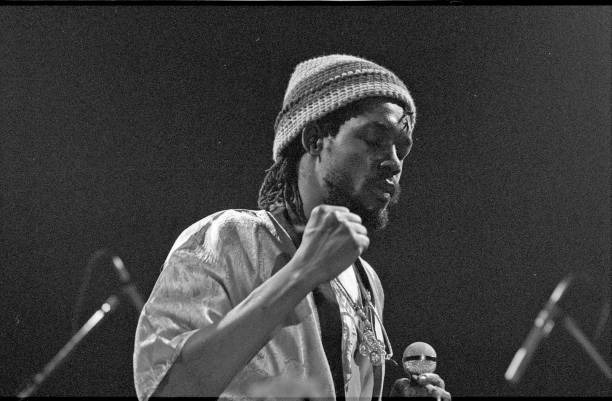Bob Marley’s best selling album, by a wide margin, is the 1984 compilation Legend. As we’ve argued previously (see “Is This Love”), Legend was purposefully marketed to white, non-reggae listeners, and it depicted Marley as a sort of spiritual prophet of love and good vibes. But Legend was heavily slanted towards the second half of Marley’s career, when he was a solo artist. Only four of the tracks on the original release predated 1977’s Exodus. Later, expanded reissues of Legend continued this trend, favoring DJ remixes of later tracks as opposed to older material.
“Kinky Reggae” does not appear on any edition of Legend. It was released in 1973, before Marley was the worldwide face of reggae, and a dozen years before Legend enshrined him as the Third World’s philosopher of positivity. In 1973, Marley was a tough street kid from Kingston, Jamaica’s Trenchtown neighborhood, a veteran performer celebrated as one third of one of the island nation’s most famous groups, the Wailers, who had been together for 12 years and had already released hundreds of singles. But his horizons were expanding, and they led him to London, a city bigger, colder and stranger than anything he had experienced back home.

Marley initially came to England to work with American singer Johnny Nash on a film soundtrack that never materialized (though it did yield a hit cover of Marley’s “Stir It Up” on Nash’s 1972 debut album I Can See Clearly Now). The rest of the Wailers (Peter Tosh, Bunny Wailer and the Barrett brothers, bassist Aston and drummer Carlton) soon joined Marley in London, with the hope of undertaking a European tour. That hope fizzled out pretty quickly: before any tour could get off the ground, Nash and his manager decamped for Miami, leaving the five Jamaicans stranded and virtually penniless. They turned to a mutual friend who connected them with Chris Blackwell of Island Records.

Blackwell –– who grew up in Jamaica and, through Island’s subsidiary Trojan Records, released hundreds of rock steady and reggae singles –– saw in the Wailers a unique opportunity to introduce this music to the wider Western audience (whom Island had already reached with rock albums from Traffic, Cat Stevens, Fairport Convention and Jethro Tull, among others). Blackwell gave the band a £4,000 advance, some of which they used to get back home to Jamaica, and the rest of which they put towards recording an album’s worth of material.
A few months later, Blackwell flew to Jamaica to hear how the Wailers were doing. As soon as he heard the tapes he felt, as he later remembered, “complete elation.” The album that resulted, Catch a Fire, was arguably the first reggae album recorded as a discreet artistic whole (as opposed to a compilation of hit singles and filler). Blackwell took the tapes back to England and, with Marley’s participation, remixed the tracks for the rock music audience, adding some bluesy rock overdubs courtesy of Muscle Shoals guitarist Wayne Perkins and Johnny Nash’s keyboardist (and future Who sideman) John “Rabbit” Bundrick.

About half the tracks on Catch a Fire were older songs that the Wailers reworked in a heavy reggae style. “Kinky Reggae” was new, probably written during Marley’s initial trip to England, if the reference in the second verse to Piccadilly Circus is any indication. Much of Catch a Fire has an almost biblical tone of lamentation (American critic Robert Christgau would later say that “these songs are worthy of St. John the Divine”). But “Kinky Reggae” is a good-time song about the temptations of a strange new city. The Barrett brothers start “Kinky Reggae” with an easy mid-tempo groove, filled out by Winston Wright’s organ accents, while Marley and Tosh provide rhythm guitar stabs (always on the upbeat, of course). The music perfectly suits the lyrics: you can almost see a young Marley sauntering down the London streets, smoking a spliff, greeting people with a nod and taking in the scene around him.
But what really makes “Kinky Reggae” distinctive is its vocal performances. Listeners who come to Bob Marley through Legend may think of him as primarily a solo singer, but if you isolate the “Kinky Reggae” lead and backup tracks in KORD, you’ll hear how the Wailers were, above all, a vocal harmony group: when Marley sang with Peter Tosh and Bunny Wailer, their combined sound was as distinctive as anything produced by the Beatles, the Impressions or fellow Jamaicans the Melodians. Here the trio echo Marley’s lead vocal in the verses, then branch out to full harmony on “Ride on…” while the organ swells in a little gospel flourish. The call-and-response is as tight as anything on Motown, and listeners familiar with the Wailers’ back catalog are no doubt reminded of similar displays of harmonic prowess on songs such as “Trenchtown Rock,” produced by Lee ‘Scratch’ Perry a few years earlier, or even the doo-wop-influenced ska records the Wailers made with producer Clemont Dodd in the early 1960s, like “Simmer Down” and “I’m Still Waiting.”

Though the lyrics of “Kinky Reggae” hint at various sexual adventures, the Wailers were by this point devout Rastafarians, and their faith declared they must eat certain foods, shun all drugs except for marijuana and maintain biblically-inspired attitudes toward relationships between men and women. London in the early 1970s was the opposite: awash in drugs, sex and a general feeling of grubby decadence. It must have caused a good deal of tension for young men trying to live a purified life. That tension was too much for Bunny Wailer: he refused to tour behind Catch a Fire, and quickly returned to Jamaica. Regardless of whether the protagonist of “Kinky Reggae” indulges temptation (“I had to hit and run”), he too ultimately decides he doesn’t want to live that life, and opts to “ride on.” This exhortation to “ride on” is repeated in another song from this period, “Midnight Ravers,” which closes Catch a Fire. Here the disgust with London nightlife is overt and almost apocalyptic –– a preview of the Old Testament tones of the next Wailers album, Burnin’.Catch a Fire introduced the Wailers to the world beyond Jamaica, but it also marks the beginning of Marley’s transition into a solo artist. In a sense, “Kinky Reggae” spans the two halves of Marley’s career: Tosh and Wailer officially left the group after Burnin’, but Marley kept “Kinky Reggae.” It remained part of his live set for years, the Wailers’ harmonies now provided by the I-Threes (Marley’s wife Rita, Judy Mowatt and Marcia Griffiths). The song appears twice on the deluxe version of the definitive Live! album, and again on its 1978 live follow-up, Babylon by Bus. But it’s the original 1973 version of “Kinky Reggae” that stands out, not only as one of the last hurrahs from a brilliant vocal trio, but as a sign of the legendary music to come.

Related Songs






